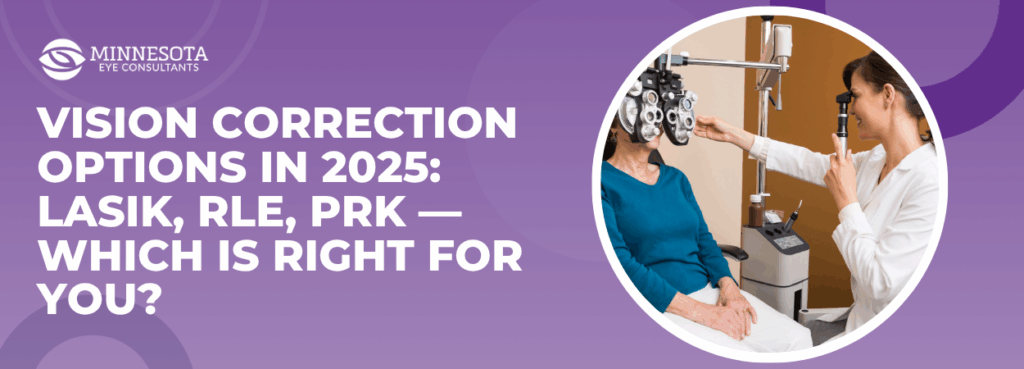
Clear vision is more achievable than ever in 2025 thanks to advanced eye surgery options like LASIK, PRK, and Refractive Lens Exchange (RLE). At Minnesota Eye Consultants, our specialists are dedicated to helping you understand which option may be right for you based on your age, lifestyle, and vision needs.
Whether you’re tired of glasses, struggling with contacts, or starting to notice age-related vision changes, this guide will walk you through your choices, symptoms to watch for, and when it may be time to schedule a consultation.
Recognizing the Signs: When Should You Consider Vision Correction?
Before you decide on a procedure, it’s important to acknowledge that your current vision might be holding you back. Vision issues often sneak up on us. If you notice any of the following symptoms, it’s time to explore your options:
- Difficulty seeing street signs while driving (a sign of nearsightedness or myopia).
- Straining to read fine print or constantly holding your phone further away (a classic symptom of presbyopia, the age-related hardening of the lens).
- Frequent headaches or eye fatigue, especially after working on a computer.
- Waking up with blurry vision before putting on your contacts or glasses.
- Colors appearing dull or experiencing glare and halos around lights at night (potential early signs of cataracts).
“LASIK, PRK, and RLE are not one-size-fits-all. The right procedure is the one that addresses your specific vision needs today and plans for your vision health for decades to come.” — Dr. Mark S. Hansen, M.D., Cornea & Refractive Specialist.
The Top 3 Vision Correction Options in the Twin Cities
Whether you’re in your 20’s dealing with nearsightedness or in your 50’s struggling with reading glasses, one of these three procedures can deliver the freedom of clear vision.
1. LASIK (Laser-Assisted In Situ Keratomileusis)
LASIK is the world’s most popular form of laser eye surgery. It’s ideal for correcting common refractive errors like nearsightedness, farsightedness, and astigmatism.
- How it Works: The surgeon creates a thin flap on the cornea’s surface, uses an excimer laser to precisely reshape the underlying corneal tissue, and then repositions the flap.
- Recovery: Patients love LASIK for its rapid recovery. Most see significant improvement within 24 hours.
- Best for: Patients generally aged 18 to mid-40s with a stable prescription and good corneal thickness.
2. PRK (Photorefractive Keratectomy)
PRK is the predecessor to LASIK and remains a fantastic option for many patients who might not be ideal LASIK candidates.
- How it Works: Unlike LASIK, PRK is a surface treatment. The outermost layer of corneal cells is gently removed before the laser reshapes the tissue. This layer then regrows naturally.
- Recovery: PRK recovery is longer than LASIK (typically a few days of discomfort, with vision stabilizing over a few weeks), but the long-term results are comparable.
- Best for: Individuals with thinner corneas, very active lifestyles (due to the absence of a flap), or certain corneal irregularities.
3. RLE (Refractive Lens Exchange)
RLE, sometimes called Clear Lens Exchange, is the most comprehensive option. It is identical to cataract surgery but is performed before a cataract has fully developed. It is often the recommended option for patients over 45 who are experiencing presbyopia and seeking permanent freedom from reading glasses.
- How it Works: The eye’s natural, aging lens is gently removed and replaced with a technologically advanced Intraocular Lens (IOL). These new lenses can correct vision at near, intermediate, and far distances.
- The Cataract Connection: Since the natural lens is removed, you will never develop cataracts in the future. This is why RLE is a fantastic proactive step for long-term vision health.
- Best for: Patients typically over 45 who struggle with reading glasses and are farsighted or have early-stage cataracts.
Learn more about our vision correction services.
Answering Your Common Vision Correction Questions (FAQ)
Q1: Am I too old for laser vision correction?
A: You are never too old to explore your options! While LASIK and PRK are generally best for younger adults, RLE is specifically designed for the needs of patients typically aged 45 and older. If you have presbyopia (need reading glasses) or developing cataracts, RLE offers a permanent solution.
Q2: What are the differences between RLE and Cataract Surgery?
A: The surgical procedure is identical. The difference is the timing. Cataract surgery removes a lens that is cloudy (cataract). RLE removes a lens that is clear but is causing focusing problems (presbyopia/farsightedness). In both cases, the lens is replaced with a premium IOL to restore clear vision.
Q3: How do I know if I have the beginning stages of a cataract?
A: Cataracts develop slowly, often causing subtle changes like blurry vision, faded colors, and increasing glare sensitivity, especially when driving at night. Regular comprehensive eye exams are the only way to catch them early. Our expert team at the Minnesota Eye Consultants clinic closest to you can diagnose your condition accurately.
Want to Learn more about Cataracts? Cataract Surgery Minneapolis | Cataracts Minneapolis | MN Eye
Q4: Is vision correction covered by my health insurance?
A: Most vision correction procedures are elective and not typically covered by insurance. However, flexible payment options are available to check your specific coverage and explore flexible payment plans, visit the Minnesota Eye Consultants patient resources page: Billing & Financing.
Q5: Who performs these procedures at Minnesota Eye Consultants?
A: Our surgeons are internationally recognized experts in the field of ophthalmology. Our practice is a leading training facility, meaning your procedure is performed by surgeons who are often teaching the techniques to other doctors worldwide. You receive cutting-edge care right here in the Twin Cities.
Check out our trusted providers at Minnesota Eye Consultants today! Eye Doctor Minneapolis | Ophthalmologist Minneapolis
What Our Patients Are Saying About Our Expert Doctors
Discover the positive impact that expert care from Minnesota Eye Consultants can have on your life.
| Doctor & Review | Patient Experience & Results |
| Dr. Thomas W. Samuelson, M.D. | “Dr. Thomas Samuelson was very professional and patient! He gave me great advice and detailed explanation regarding my eye problem. It helped me to make the most suitable decision to solve my eye issue. I am very happy to have had Dr. Samuelson do my eye surgery!” |
| Dr. Mark S. Hansen, M.D. | “Awesome surgeon and person. Dr Hansen took the time to call me and see how I was doing the evening of my surgery. 20/30 vision less than 24 hours after cataract surgery. Thank You for your Excellent work and kindness.” |
Why Choose Minnesota Eye Consultants for Your Vision Needs?
We are committed to delivering the best vision results across the Twin Cities metro area. Our comprehensive range of services, from Primary Eye Care and Specialty Contact Lenses to advanced Glaucoma and Cornea treatments, ensures we can care for your vision at every stage of life. Our clinics in Blaine, Minnetonka, Woodbury, and Bloomington utilize the latest technology to ensure precise, customized outcomes, whether you need LASIK, PRK, or RLE.
Find Your Nearest MN Eye Location: Ophthalmologist Minneapolis | Eye Doctor Minneapolis | MN Eye Locations
Ready to Schedule Your Consultation?
The path to clear vision begins with a comprehensive consultation with one of our experienced Ophthalmologists in Minneapolis and the surrounding communities. We will determine if LASIK, PRK, or Refractive Lens Exchange is your best option.
Don’t wait to experience life in high definition. Call Now: (952) 888-5800!









